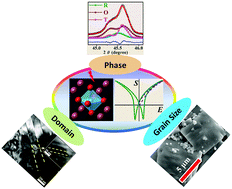Effects of a phase engineering strategy on the strain properties in KNN-based ceramics†
Abstract
In this work, (0.99 − x)(K0.5Na0.5)(Nb0.965Sb0.035)O3–0.01SrZrO3–x(Bi0.5Na0.5)ZrO3 ceramics were selected to show how a phase engineering strategy (PES) affects the strain properties in potassium sodium niobate (KNN)-based ceramics. The application of PES resulted in the coexistence of multiple phases in KNN-based ceramics accompanied by an increased diffuseness of ferroelectricity and decreased domain size. The strain properties, including the dependencies of strain on composition, temperature and fatigue behavior, were evaluated by considering the phase structure, domain configuration and microstructure. The improved room-temperature strain properties of the KNN-based ceramics with PES originated from the converse piezoelectric response, domain switching and possible electric-induced phase transition, which resulted from the coexistence of multiple phases and complex domain configuration. The enhanced temperature stability mainly originated from the converse piezoelectric response. Endurable fatigue resistance (no degradation within 100–105 electric cycles) and a high electrostriction coefficient (Q33 = 0.035 m4 C−2) were observed in the ceramics with x = 0.03 and 0.05, respectively. This study provides a systematic analysis of the effects of PES on strain properties in KNN-based ceramics.



 Please wait while we load your content...
Please wait while we load your content...